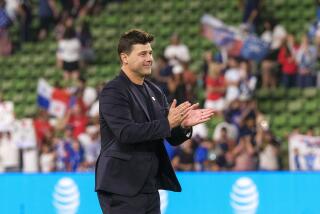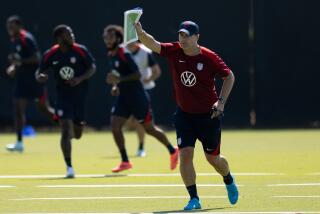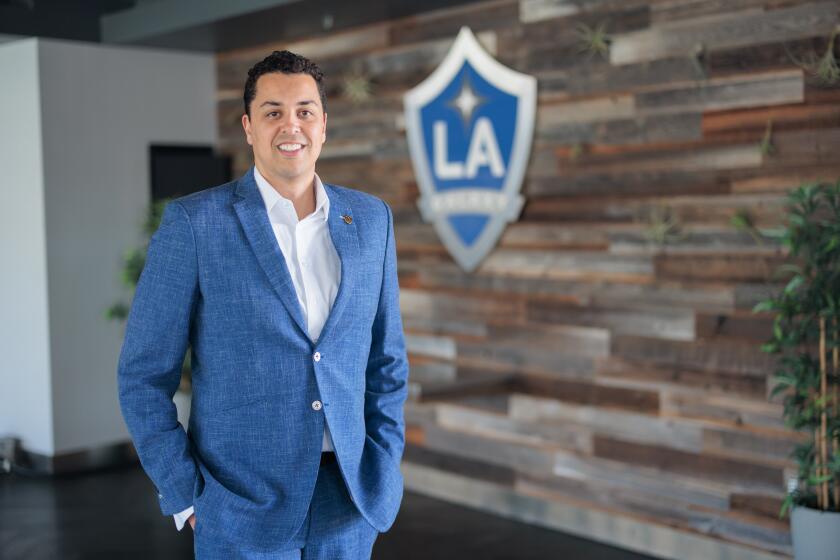Win World Cup by 2010? U.S. Has $50-Million Shot
WASHINGTON â Within the space of an hour or so on Friday, the vast gulf between the future of soccer in the United States and the present state of the sport was revealed in no uncertain terms.
Inside RFK Stadium, the powers that be in the sport outlined an ambitious $50-million plan--quickly dubbed the âRothenberg Initiativeâ--that is intended to guide the United States to victory in the World Cup by the year 2010.
On the field itself, the current crop of American World Cup players and coaches was being interviewed about France â98.
Over here, Claudio Reyna was speaking in German to a German television crew. Over there, David Regis was speaking in French to a radio reporter from France. A little way away, Coach Steve Sampson was speaking in Spanish to a local writer, while nearby goalkeeper Brad Friedel joked in English with another computer-toting (theyâre not ink-stained anymore) wretch.
The U.S. national team--like the country it represents--talks in many tongues, but on Friday at least, U.S. Soccer was speaking with one voice.
And the message it delivered was clear: Starting now, an unprecedented commitment will be made to the development of players in this country, beginning at the under-14 level and progressing all the way to the full menâs and womenâs national teams.
âIf we ever hope to get it right at the World Cup level, we must experience success at the youth team level,â said Tom King, general manager of U.S. national teams. âOur goal is to win a [FIFA] World Youth Championship by the year 2005.â
Since players have to be under 20 to compete in that tournament, it means that todayâs 12- and 13-year-olds are the potential world champions of 2005. U.S. Soccer now recognizes that they have to be identified and put in a professional training environment as quickly as possible, bypassing the school and college soccer programs that, with rare exceptions, have failed to make the U.S. competitive internationally.
On a morning of colorful flip-charts, complex graphs and bang-on-the-table speeches, U.S. Soccer also stated its determination to win an under-17 world championship by 2005 and a menâs Olympic gold medal by 2008.
Since American women already have a world championship and a gold medal to their credit, the motto for them is simple, King said. Itâs âWin Forever.â
The World Cup itself, however, remains the ultimate objective of a plan that formally is known as Project 2010.
âIn order to win a World Cup in 2010, we must be capable of winning it by the year 2006,â King said. âOur goal is to reach the second round or beyond in France. The quarterfinals is our goal in Japan and South Korea [in 2002] and the semifinals in the year 2006.â
Those are lofty ambitions, and unless the players are found who can carry out those wishes, they will remain nothing but pipe dreams.
âThe only way weâre going to get better on the international level is by giving players a higher level of experience and training at a younger age,â said Sunil Gulati, vice president of U.S. Soccerâs professional division and deputy commissioner of Major League Soccer. âWe hear that across the board from everybody whoâs involved in the game at the international level.â
Toward that end, several initiatives are being launched:
* A full-time residency program is being established at the Bollettieri Soccer Academy in Bradenton, Fla. Training there will be by national staff coaches. Full tuition, room and board will be covered by U.S. Soccer. The first age group to take advantage of that will be the boysâ under-17 national team, now pointing toward the 1999 world championship.
* Project 40, a joint initiative by U.S. Soccer and MLS in which players can bypass college soccer and turn professional straight out of high school--with the federation and the league picking up their education costs so they can still earn their degrees--will be expanded each year.
Currently, there are 22 Project 40 players playing as a team in the A-League, MLSâ minor league affiliate. By 2010, there will be 120.
* U.S. Soccer will launch a player development opportunity program that will allow 360 players ages 12 to 20 a total of 75 days of training and matches under national coaches starting in 1999.
The number of players and the number of days will be increased annually until they reach 1,000 players and 100 days in 2010.
* A nationwide scouting system will be put in place. The scouts will be charged with locating the most promising players at all age levels, with particular emphasis on Hispanic and inner-city areas that have been largely overlooked by the Olympic development program.
âWe want to see players in a natural environment,â Gulati said. âFrankly, all of our people agree that an invitational all-star game is not a natural environment. Itâs not how itâs done anywhere else in the world. Itâs not the right way to identify players.â
Scouts, Gulati said, would see players with their club teams several times a year and be able to gauge their progress. The scouting system also would pick up players who currently are slipping through the net.
âWe can look at players who either canât afford, or donât know about or canât get transport to wherever that all-star tryout is,â he said. âPlayers, especially in the inner cities, who might otherwise get missed for any of those reasons.â
* An international residency program is being planned in which youth players would be sent abroad to train.
âIf, for example, we have three [regional] teams in the under-14 group, we would have a fourth team that would spend [time] abroad,â Gulati said. âThis yearâs U-14 best players would be next yearâs U-15 residency players in Europe or in South America.
âThe notion of getting players into a little bit different environment than weâve got in the U.S., of spending two or three months in Brazil or Argentina or England or Germany or wherever it might be, having that sort of soccer culture where there is a professional environment on a day-to-day basis, where there is soccer on television round the clock, thatâs a very important part of what weâre trying to do as well.â
The revolution in thinking by U.S. Soccer stems from a question that Alan Rothenberg, U.S. Soccerâs president and the founder of MLS, raised two years ago. He wanted to know what it would take for the U.S. to win the World Cup in his lifetime.
Project 2010--the âRothenberg Initiativeâ as MLS Commissioner Doug Logan called it Friday--was the answer.
It was only a paper plan until Nike and IMG poured tens of millions of dollars into U.S. Soccerâs coffers earlier this year, but the resources are now there to make it a reality.
âIf you study the rest of the successful [soccer] federations around the world, they have a number of common aspects that make them successful,â said Hank Steinbrecher, U.S. Soccerâs executive director and general secretary.
âMost of them have great player development. They also have strong coaching developmental programs. They have strong refereeing programs. Theyâve built an infrastructure to support those and they have political will to execute them.
âI believe this plan, 2010, the Rothenberg Initiative, however we wish to refer to it, has all of those aspects and I know it can succeed.â
But it was Rothenberg himself Friday who might have stumbled on the real key to its success or failure.
He pointed out that Ronaldo, the player who is supposed to lead defending champion Brazil to an unprecedented fifth World Cup in the coming weeks, is only 21.
That meanâs U.S. Soccerâs task, if it really wants to win the World Cup in 2010, is to find the 9-year-old who can be that player a dozen years from now.
The search is on.






